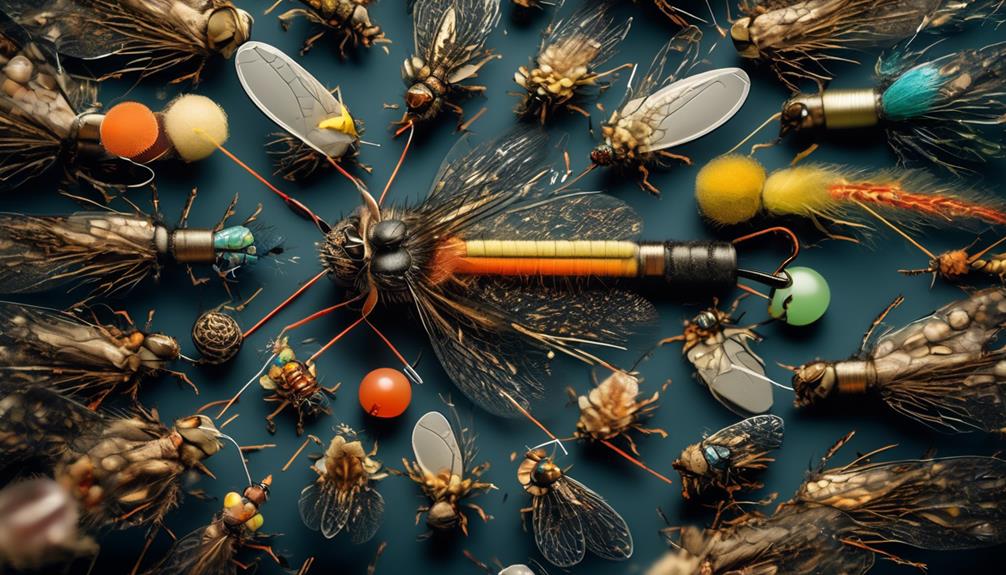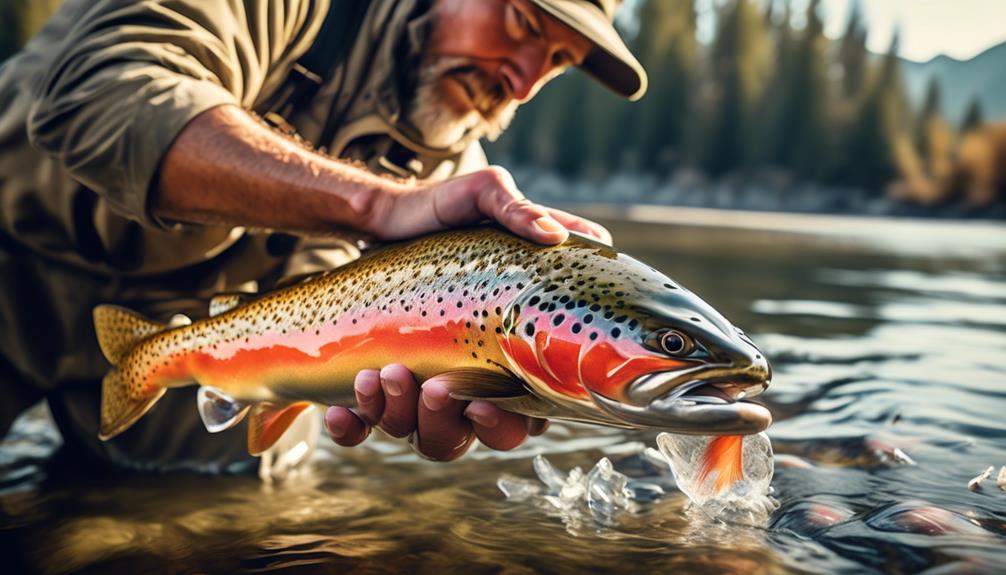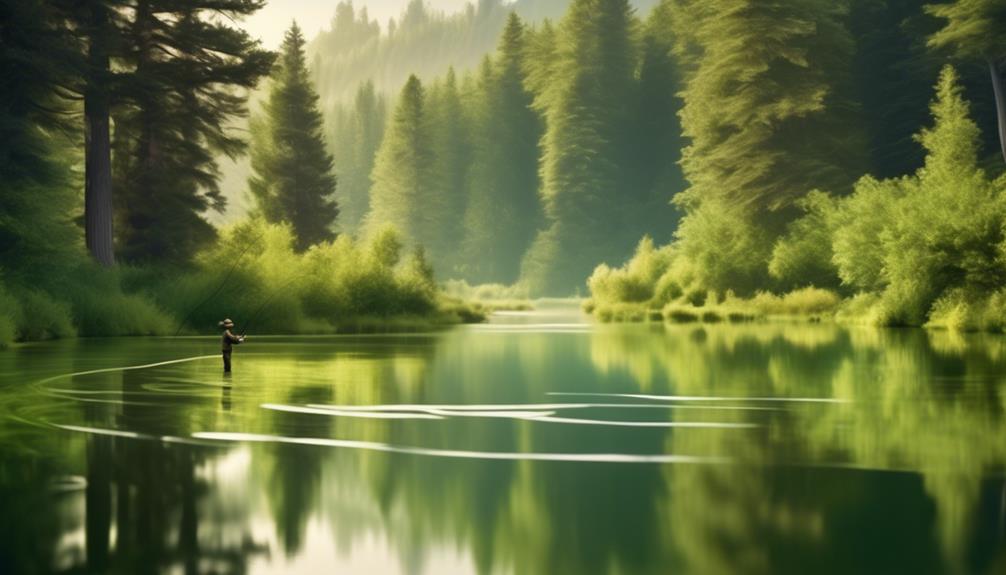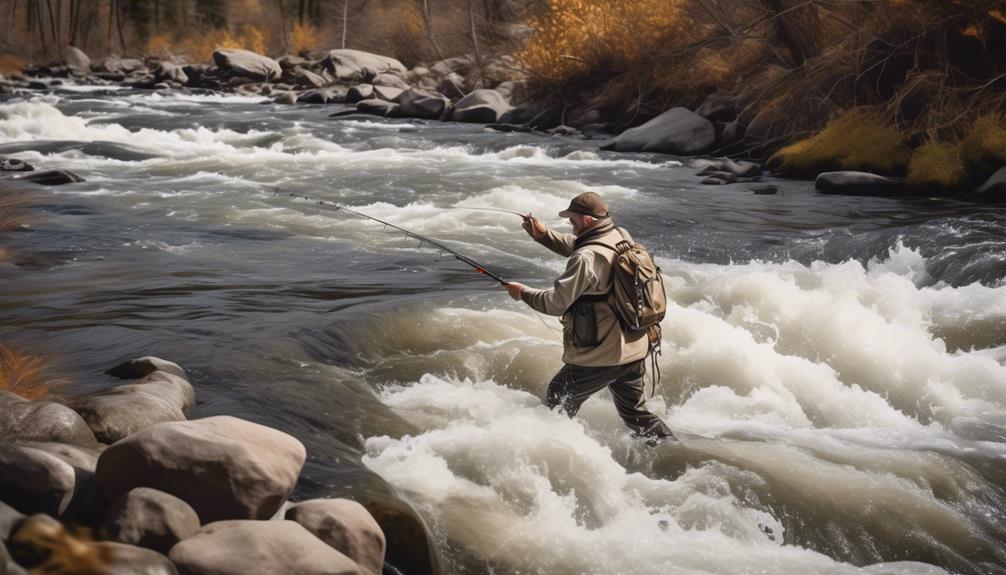You've probably heard the saying, 'Match the hatch,' but knowing how to do that effectively is an entirely different matter. Understanding the intricate world of fly fishing hatches and being able to match them is a skill that can significantly improve your success on the water.
From identifying insect hatches to selecting the right fly patterns and mastering presentation techniques, there's a lot to cover. And if you've ever struggled with getting the right match, fret not; this guide will equip you with the knowledge and strategies to elevate your fly fishing game.
Understanding Fly Fishing Hatches
Understanding fly fishing hatches can greatly enhance your success on the water, as it allows you to effectively match the insects the fish are feeding on. Insect behavior plays a crucial role in fly fishing. When you observe the behavior of the insects on the water, you gain valuable insights into what fly patterns to use.
For example, if you notice that the insects are skittering across the water's surface, it indicates that they're emerging, and you should consider using a dry fly pattern that mimics this behavior. Conversely, if you see the insects diving below the water's surface, it suggests that they're laying eggs, prompting you to use a nymph pattern to imitate this action. Understanding these subtleties in insect behavior can make a significant difference in your fly fishing success.
Fly pattern variations are another key aspect of understanding fly fishing hatches. Different stages of insect development require different fly patterns to effectively mimic them. For instance, during a mayfly hatch, you may need to use multiple fly patterns to imitate the various stages of mayfly development, such as the nymph, emerger, and adult dun.
Identifying Insect Hatches
To identify insect hatches, closely observe the surface of the water for any signs of insect activity. Look for any movement or fluttering on the water's surface, as this could indicate an emerging hatch. Understanding the insect life cycle is vital in identifying hatches. Insects go through stages such as egg, nymph, pupa, and adult. By knowing these stages, you can anticipate when specific insects will hatch and tailor your fly pattern selection accordingly.
When observing the surface of the water, pay attention to any small insects floating or flying around. This is a clear sign that a hatch is underway. Additionally, look for any adult insects sitting on the surface or emerging from the water. These visual cues can help you match the hatch with the appropriate fly pattern.
Insect hatches can vary depending on the time of year and the specific body of water you're fishing in. Keep in mind that different insects hatch at different times, so it's essential to be observant and adaptable. By understanding the insect life cycle and being attentive to the signs of hatching, you can improve your fly pattern selection, leading to a more successful and enjoyable fly fishing experience.
Importance of Matching the Hatch
Matching the hatch is crucial for successful fly fishing, as it allows you to imitate the natural food source of the fish, increasing your chances of a successful catch. When you match the hatch effectively, you're essentially presenting the fish with what they're naturally feeding on, making your fly more appealing and increasing the likelihood of a strike.
It is important to understand the significance of matching the hatch. Here's why:
- Hatch Patterns: Matching the hatch involves identifying the specific insects hatching at a particular time and location. Understanding these hatch patterns is essential for selecting the right fly to imitate the insects.
- Fly Selection: By matching the hatch, you can select the appropriate fly pattern that closely resembles the insects on which the fish are feeding. This increases the chances of the fish recognizing your fly as natural prey and striking.
- Increased Effectiveness: Matching the hatch significantly increases the effectiveness of your fly fishing. It allows you to capitalize on the fish's natural feeding behavior, making your presentation more enticing and realistic.
- Enhanced Fishing Experience: Successfully matching the hatch leads to a more authentic and immersive fly fishing experience. It requires observation, knowledge, and skill, adding an element of challenge and satisfaction to the sport.
Selecting the Right Fly Patterns
When you're on the water, your success in matching the hatch relies heavily on selecting the right fly patterns that closely resemble the natural insects the fish are feeding on. Fly pattern selection is a crucial aspect of hatch matching strategies.
To begin with, observe the insects around you and take note of their size, color, and behavior. This will help you determine the appropriate fly patterns to use. For example, if you notice that the fish are feeding on small, dark-colored mayflies, then selecting a fly pattern that mimics this specific insect will greatly increase your chances of a successful catch.
Additionally, it's important to consider the stage of the insects in their life cycle. Are they emerging, laying eggs, or in their adult form? Matching the stage of the hatch is equally important when selecting fly patterns. For instance, if you notice fish targeting emerging caddisflies, choosing a fly pattern that imitates the emerging stage of the caddisfly will be more effective than using a pattern that represents the adult caddisfly.
Furthermore, having a variety of fly patterns in your fly box is advantageous as it allows you to adapt to changing conditions on the water. Different patterns may be needed depending on the time of day, weather, and the specific behavior of the fish.
Techniques for Presenting Flies
Consider employing a drag-free drift to present your fly naturally and entice the fish to strike. This technique involves casting your fly upstream and allowing it to float downstream without any interference from the line, imitating the natural movement of insects on the water's surface.
Here are some key techniques for effectively presenting your flies:
- Fly placement: Focus on placing your fly in areas where fish are likely to feed, such as near rocks, fallen trees, or along the seams between fast and slow-moving water. Observing the water's surface for any signs of rising fish or insect activity can also guide your fly placement.
- Distance casting: Practicing distance casting can significantly improve your ability to reach fish in challenging or remote locations. By mastering this skill, you can effectively cover a wider area of water and target fish that may be less susceptible to close-range presentations.
- Mending: Learning how to mend your line is crucial for achieving a drag-free drift. By making slight adjustments to the position of your line on the water's surface, you can minimize any unnatural movement that may deter fish from striking your fly.
- Reading the water: Understanding the various currents, eddies, and riffles within a river or stream is essential for presenting your fly effectively. By reading the water, you can anticipate where your fly will drift and adjust your presentation accordingly to increase your chances of enticing a strike.
Timing and Location for Hatches
To maximize your chances of success, timing your fishing excursions to coincide with insect hatches and understanding the locations where hatches typically occur is essential. The best timing for hatches depends on the specific species of insects and local environmental conditions. Generally, hatches occur during specific times of the day, often in the morning or evening. It's crucial to research and observe the hatching patterns of insects in the area you plan to fish. Keep in mind that weather and water temperature play significant roles in determining the ideal timing for hatches. Warm and stable weather conditions often lead to more predictable hatches, while fluctuating weather patterns can disrupt insect emergence.
When it comes to ideal locations for hatches, rivers, streams, and lakes with healthy aquatic ecosystems are prime spots. Look for sections with ample vegetation, as these areas are likely to host a variety of insect species and provide suitable habitat for their development. Additionally, areas with slow-moving or still water, such as eddies and backwaters, are often rich in insect life, making them potential hotspots for hatches.
Adapting to Changing Hatch Conditions

If you encounter changing hatch conditions while fly fishing, adjust your approach by observing the water surface for any signs of emerging insects. Adapting strategies to changing hatch conditions is crucial for a successful fly fishing experience.
Environmental factors such as weather, water temperature, and time of day can all influence insect activity and hatch patterns. Here are some key strategies to help you adapt to changing hatch conditions:
- Stay observant: Keep a close eye on the water surface for any signs of insect activity or emerging insects. This will help you identify the specific insects that are hatching and allow you to select the appropriate fly pattern to match the hatch.
- Be flexible with your fly selection: Carry a variety of fly patterns in different sizes and colors to mimic the insects that may be hatching. Being prepared with a diverse selection of flies will enable you to quickly adapt to changing hatch conditions.
- Adjust your presentation: Pay attention to how the insects are behaving on the water and try to mimic their movements and behavior with your fly presentation. This may involve adjusting your casting technique, drift, or retrieve to closely imitate the natural insects.
- Experiment with different depths and speeds: If you notice that the insects are hatching at different depths or the current is affecting their movement, try adjusting the depth and speed of your fly presentation to match the natural insects' behavior.
Tips for Successful Hatch Matching
When adapting to changing hatch conditions while fly fishing, successfully matching the hatch relies on observing the water surface for signs of emerging insects and selecting the appropriate fly pattern. Proper fly selection is crucial for a successful hatch matching experience. To ensure you're using the correct fly pattern, closely observe the insects around you. Look for their size, color, and behavior. This will help you determine the most suitable fly to imitate the natural insects and increase your chances of a successful catch.
Effective presentation techniques are equally important for a successful hatch matching. Once you have selected the proper fly pattern, pay attention to how you present it to the fish. Make sure your fly drifts naturally on the water, mirroring the movement of the natural insects. This may involve adjusting your casting technique and mending the line to avoid any unnatural drag that could alert the fish.
Additionally, consider the depth at which the insects are hatching and adjust your presentation accordingly. If the insects are emerging closer to the surface, use a floating line and position your fly accordingly. Conversely, if they're hatching deeper, consider using a sinking line or weighted flies to reach the appropriate depth.
Frequently Asked Questions
How Can I Determine the Best Hatch Matching Technique for Different Types of Water Conditions?
To determine the best hatch matching technique for different water conditions, consider the hatch timing and environmental factors. Adjust your fly selection based on the specific insects present and the water temperature, clarity, and flow.
What Are Some Common Mistakes That Fly Fishers Make When Trying to Match the Hatch?
When trying to match the hatch, common mistakes include overlooking details and improper fly selection. Proper observation of insect behavior and water conditions is crucial. Avoid rushing and take the time to make the right choice.
Are There Any Specific Fly Patterns That Work Well for Imitating Multiple Types of Insect Hatches?
When it comes to fly pattern versatility, some patterns work well for imitating multiple types of insect hatches. These flies are great for imitating a variety of insects, making them versatile additions to your fly box.
What Are Some Advanced Techniques for Presenting Flies During a Hatch?
When presenting flies during a hatch, timing strategy is crucial. Adjust your presentation techniques based on the specific hatch. Experiment with drift speed and depth to mimic natural insect behavior and entice more strikes.
How Can I Predict or Anticipate Changes in Hatch Conditions While on the Water?
To anticipate changes in hatch conditions while on the water, observe water temperature and timing of hatches. By paying attention to these factors, you can predict when hatches may occur and adjust your fly fishing strategy accordingly.
Conclusion
So, there you have it – the ultimate guide to fly fishing hatches and matching. By understanding the hatches, identifying insect types, and selecting the right fly patterns, you can greatly increase your success on the water.
Remember to pay attention to timing and location, and be prepared to adapt to changing conditions. With these tips and techniques in mind, you'll be well-equipped to match the hatch and catch more fish on your next fly fishing adventure.
Happy fishing!



